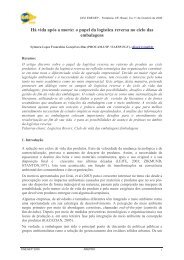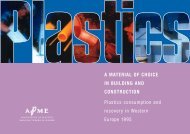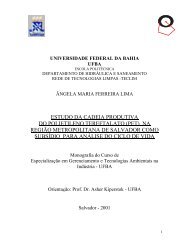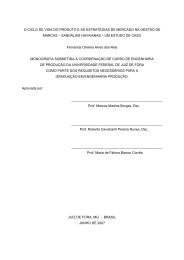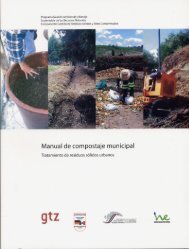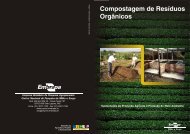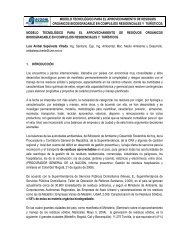Solar Energy Harvesting at Closed Landfill Sites | Engineering Cases
Solar Energy Harvesting at Closed Landfill Sites | Engineering Cases
Solar Energy Harvesting at Closed Landfill Sites | Engineering Cases
Create successful ePaper yourself
Turn your PDF publications into a flip-book with our unique Google optimized e-Paper software.
31/05/2011 <strong>Solar</strong> <strong>Energy</strong> <strong>Harvesting</strong> <strong>at</strong> <strong>Closed</strong> Landf…50 years. The two main types of systems used for harnessing solar energy are:1. <strong>Solar</strong> collectors with mirrored surfaces th<strong>at</strong> reflect sunlight to he<strong>at</strong> liquid, gener<strong>at</strong>ing electricity through steam power2. Photovoltaic (PV) cells th<strong>at</strong> absorb direct sunlightAlthough solar energy is free, harnessing solar energy requires investment. Some factors th<strong>at</strong> should be considered in the selection ofsolar harvesting systems include the following (Miggins, 2008):1. Type of solar harvesting system to be used for a specific applic<strong>at</strong>ion (mono, poly, amorphous, ribbon, concentr<strong>at</strong>ed, silicon- orcopper-based)2. <strong>Solar</strong> density (w<strong>at</strong>ts per square foot)3. Efficiency (conversion of light to energy)4. Durability (ability to withstand environmental factors)5. Physical properties of the surface and the solar system (he<strong>at</strong> tolerance, mounting, wiring, grounding, spacing requirements)6. Appearance, form and function, and dual-use deployment7. Manufacturer and availability, warranty, maintenance requirements, and useful life<strong>Closed</strong> landfill sites generally are developed as open areas and public parks, but some sites have been developed for active uses such assports complexes and shopping malls (Tansel, 1998). Recently, a number of closed landfills have been considered as potential sites forrenewable energy gener<strong>at</strong>ion (i.e., capturing energy from wind or sun). The city of Houston was awarded $50,000 from the U.S.Environmental Protection Agency (EPA) to develop a solar energy plant on a closed landfill to revitalize a 300-acre site near downtown(Barry and Tillman, 2008). Florida Power & Light (FPL) developed a solar energy project about half the size of a football field on aSarasota County landfill, fulfilling a promise to customers (Mayk, 2006). The New Jersey Meadowlands Commission (NJMC) isplanning to gener<strong>at</strong>e approxim<strong>at</strong>ely 5 megaw<strong>at</strong>ts of energy from solar harvesting on a landfill to produce renewable energy and encouragebusinesses to take advantage of the st<strong>at</strong>e’s growing green economy (Aberback, 2008). The Tessman Road <strong>Landfill</strong> in San Antonio,Texas, will be capped with a flexible solar energy–capturing cover consisting of more than 1,000 strips with photovoltaic silicon cells(Herrera, 2009). The placement of solar covers can reduce inspection and maintenance costs <strong>at</strong> the site while providing effective odorcontrol and storm w<strong>at</strong>er management.<strong>Landfill</strong> CharacteristicsThe design and oper<strong>at</strong>ional characteristics of a landfill th<strong>at</strong> may affect PV system install<strong>at</strong>ion and efficiency include the site area,topography, loc<strong>at</strong>ion, postclosure plans, cap system, and runoff control:Area: <strong>Closed</strong> sites are suitable to be developed as power parks if they have a large area with suitable orient<strong>at</strong>ion (i.e., southfacing).Topography: Evenness and symmetry in the landfill shape are important factors for the layout of a solar power–harvesting system.The shape of the landfill may affect the wind load and panel layout configur<strong>at</strong>ion. It is necessary to optimize the use of thetopography in rel<strong>at</strong>ion to wind load and panel layout for improved performance. The design and development of a site can beconfigured on the basis of the degree of comp<strong>at</strong>ibility of the finished site topography with solar energy–harvesting potential.Urban and rural loc<strong>at</strong>ion: Urban sites are closer to the power grid and the distribution system; hence, the losses duringdistribution are rel<strong>at</strong>ively small. Rural areas with high customer potential could be considered for solar systems. However, PVsystems can provide a sustainable altern<strong>at</strong>ive to help meet the increasing demands in urban areas.Postclosure plans: This project evalu<strong>at</strong>ed the postclosure use of well-maintained landfill sites. It is necessary to reevalu<strong>at</strong>e theimplement<strong>at</strong>ion of the postclosure care plan and maintenance needs <strong>at</strong> the candid<strong>at</strong>e sites for install<strong>at</strong>ion of the PV system forcomp<strong>at</strong>ibility of the existing infrastructure with the install<strong>at</strong>ion and maintenance requirements of the PV system.Geographical orient<strong>at</strong>ion: Site slopes and orient<strong>at</strong>ion are important because of the p<strong>at</strong>h of the sun during the day and sun/earthrot<strong>at</strong>ion during the year. The angles <strong>at</strong> which the surfaces receive sunlight are critical for the efficiency of a PV system. <strong>Sites</strong> withlarger areas facing south, fl<strong>at</strong> areas, and slopes between 0.2 m/m and 0.4 m/m are more suitable for install<strong>at</strong>ion of solar harvestingsystems.Cap system: In the solar energy interaction with the PV system, it was seen th<strong>at</strong> photovoltaic systems follow the most efficientangle by which the sun’s rays strike the solar panel. This angle is called the angle of incidence. A good angle of incidence producesmore energy. For this reason, solar panels have to be tilted to benefit from the best range of the solar incidence. The tilted panelsmust be mounted on found<strong>at</strong>ion systems th<strong>at</strong> can withstand wind loads while being comp<strong>at</strong>ible with the stability of the cap.Runoff control: Runoff management in landfills is achieved by infiltr<strong>at</strong>ion of w<strong>at</strong>er first through a veget<strong>at</strong>ive support layer and thenthrough a soil layer where the w<strong>at</strong>er is conveyed to surface w<strong>at</strong>er ditches and ponds. Placement of the solar panels on the landfillmay affect the runoff quantity and p<strong>at</strong>terns. Control and maintenance of the veget<strong>at</strong>ive cover must be evalu<strong>at</strong>ed so th<strong>at</strong> suitableveget<strong>at</strong>ive cover th<strong>at</strong> requires less maintenance can be utilized to minimize site access.<strong>Solar</strong> <strong>Energy</strong> Capture SystemsAlthough solar energy is a freely available renewable resource, its utiliz<strong>at</strong>ion to gener<strong>at</strong>e electricity involves either photovoltaic or solarthermal technologies.…knovelblogs.com/…/solar-energy-harv… 2/6







